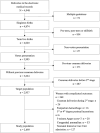Labor patterns of spontaneous first-stage labor in Chinese women with normal neonatal outcomes
- PMID: 38959186
- PMCID: PMC11221650
- DOI: 10.1371/journal.pone.0305243
Labor patterns of spontaneous first-stage labor in Chinese women with normal neonatal outcomes
Abstract
Background: Friedman's standards, developed almost 50 years ago, may no longer align with the needs of today's obstetric population and current pregnancy management practices. This study aims to analyze contemporary labor patterns and estimate labor duration in China, focusing on first-stage labor data from Chinese parturients with a spontaneous onset of labor.
Methods: This retrospective observational study utilized data from electronic medical records of a tertiary hospital in Changsha, Hunan. Out of a total of 2,689 parturients, exclusions were made for multiple gestations, preterm, post-term, or stillbirth, cesarean delivery, non-vertex presentation, and neonatal intensive care unit admission. Average labor curves were constructed by parity using repeated-measure analysis, and labor duration was estimated through interval-censored regression, stratified by cervical dilation at admission. We performed an analysis to assess the impact of oxytocin augmentation and amniotomy on labor progression and conducted a sensitivity analysis using women with complicated outcomes.
Results: Nulliparous women take over 180 minutes for cervical dilation from 3 to 4 cm, and the duration from 5 to 6 cm exceeds 145 minutes. Multiparous women experience shorter labor durations than nulliparous. Labor acceleration is observed after 5 cm in nulliparous, but no distinct inflection point is evident in the average labor curve. In the second stage of labor, the 95th percentile for nulliparous, with and without epidural analgesia, is 142 minutes and 127 minutes, respectively.
Conclusions: These findings provide valuable insights for the reassessment of labor and delivery processes in contemporary obstetric populations, including current Chinese obstetric practice.
Copyright: © 2024 Peng et al. This is an open access article distributed under the terms of the Creative Commons Attribution License, which permits unrestricted use, distribution, and reproduction in any medium, provided the original author and source are credited.
Conflict of interest statement
The authors have declared that no competing interests exist.
Figures



Similar articles
-
Contemporary patterns of spontaneous labor with normal neonatal outcomes.Obstet Gynecol. 2010 Dec;116(6):1281-1287. doi: 10.1097/AOG.0b013e3181fdef6e. Obstet Gynecol. 2010. PMID: 21099592 Free PMC article.
-
Factors affecting labor duration in Chinese pregnant women.Medicine (Baltimore). 2018 Dec;97(52):e13901. doi: 10.1097/MD.0000000000013901. Medicine (Baltimore). 2018. PMID: 30593204 Free PMC article.
-
Latent phase duration and associated outcomes: a contemporary, population-based observational study.Am J Obstet Gynecol. 2023 May;228(5S):S1025-S1036.e9. doi: 10.1016/j.ajog.2022.10.003. Epub 2023 Mar 15. Am J Obstet Gynecol. 2023. PMID: 37164487 Free PMC article.
-
Diagnosis and management of arrest disorders: duration to wait.Semin Perinatol. 2012 Oct;36(5):374-8. doi: 10.1053/j.semperi.2012.04.022. Semin Perinatol. 2012. PMID: 23009971 Review.
-
What is the slowest-yet-normal cervical dilation rate among nulliparous women with spontaneous labor onset?J Obstet Gynecol Neonatal Nurs. 2010 Jul-Aug;39(4):361-9. doi: 10.1111/j.1552-6909.2010.01154.x. J Obstet Gynecol Neonatal Nurs. 2010. PMID: 20629924 Free PMC article. Review.
References
-
- Friedman EA. Labor: clinical evaluation and management. Appleton-Century-Crofts; 1978.
Publication types
MeSH terms
Substances
LinkOut - more resources
Full Text Sources

